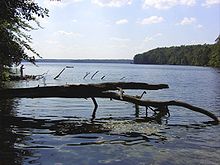Thermal pollution
Thermal pollution is the rise or drop in the temperature of a natural body of water caused by human influence.
[1] Urban runoff—stormwater discharged to surface waters from rooftops, roads, and parking lots—and reservoirs can also be a source of thermal pollution.
Converting facilities from once-through cooling to closed-loop systems can significantly decrease the thermal pollution emitted.
These related systems for managing runoff are components of an expanding urban design approach commonly called green infrastructure.
[16] Retention basins (stormwater ponds) tend to be less effective at reducing runoff temperature, as the water may be heated by the sun before being discharged to a receiving stream.
[17] Elevated temperature typically decreases the level of dissolved oxygen and of water, as gases are less soluble in hotter liquids.
Thermal pollution may also increase the metabolic rate of aquatic animals, as enzyme activity, resulting in these organisms consuming more food in a shorter time than if their environment were not changed.
The increased temperature can also change the balance of microbial growth, including the rate of algae blooms which reduce dissolved oxygen concentrations.
Decreased enzyme activity in aquatic organisms can cause problems such as the inability to break down lipids, which leads to malnutrition.
This can lead to toxic outcomes for these species, as well as build up of heavy metals in higher trophic levels in the food chain, increasing human exposures via dietary ingestion.
[21] In limited cases, warm water has little deleterious effect and may even lead to improved function of the receiving aquatic ecosystem.
An extreme case is derived from the aggregational habits of the manatee, which often uses power plant discharge sites during winter.
[23] In Australia, where many rivers have warmer temperature regimes, native fish species have been eliminated, and macroinvertebrate fauna have been drastically altered.
[25] When power plants are active, short term water temperature increases are correlated with electrical needs, with more coolant released during the winter months.
[26][27] Similar to effects seen in aquatic systems due to climatic warming of water, thermal pollution has also been seen to increase surface temperatures in the summer.
Rivers and large bodies of water also tend to lose the effects of thermal pollution as they progress from the source.




